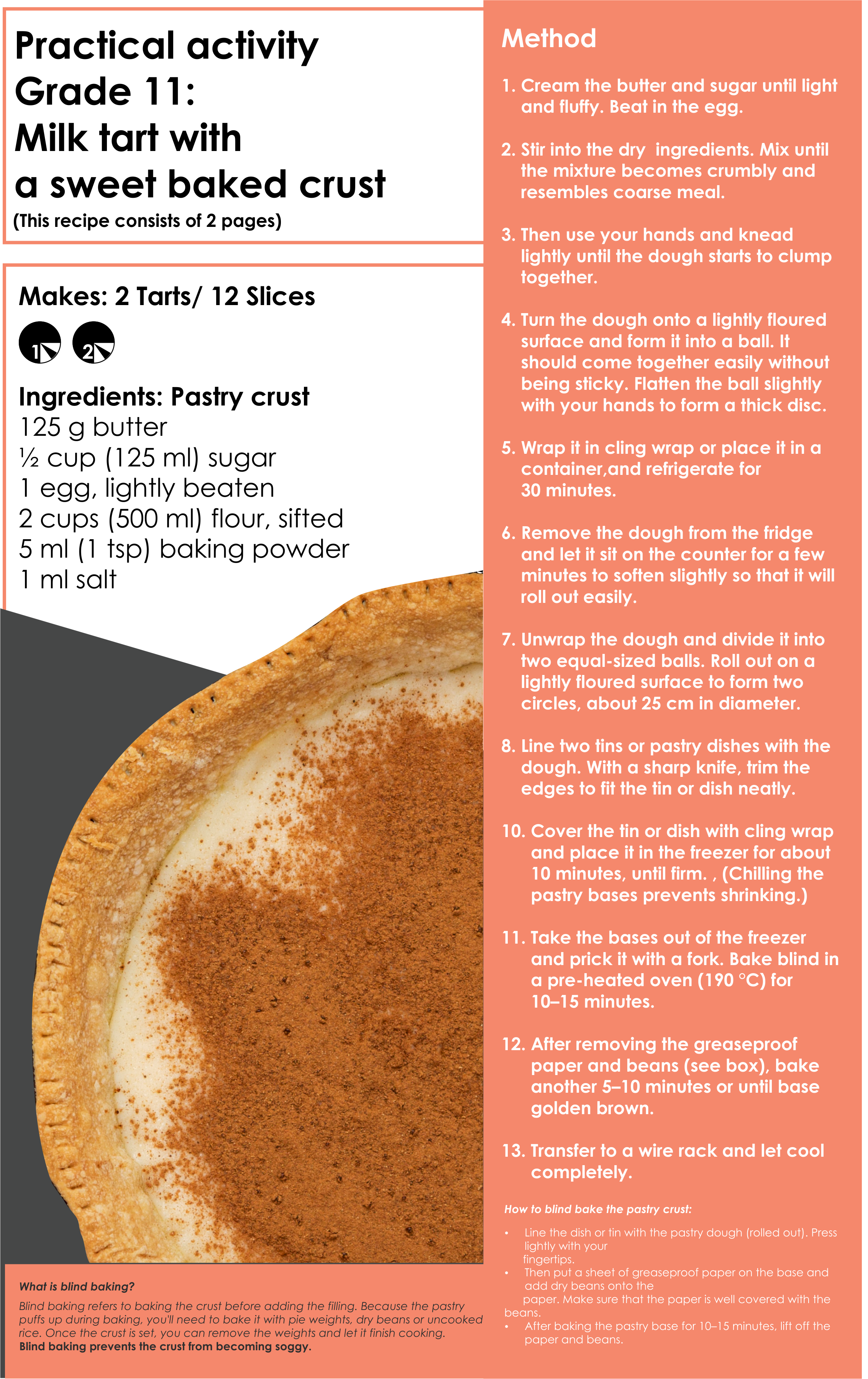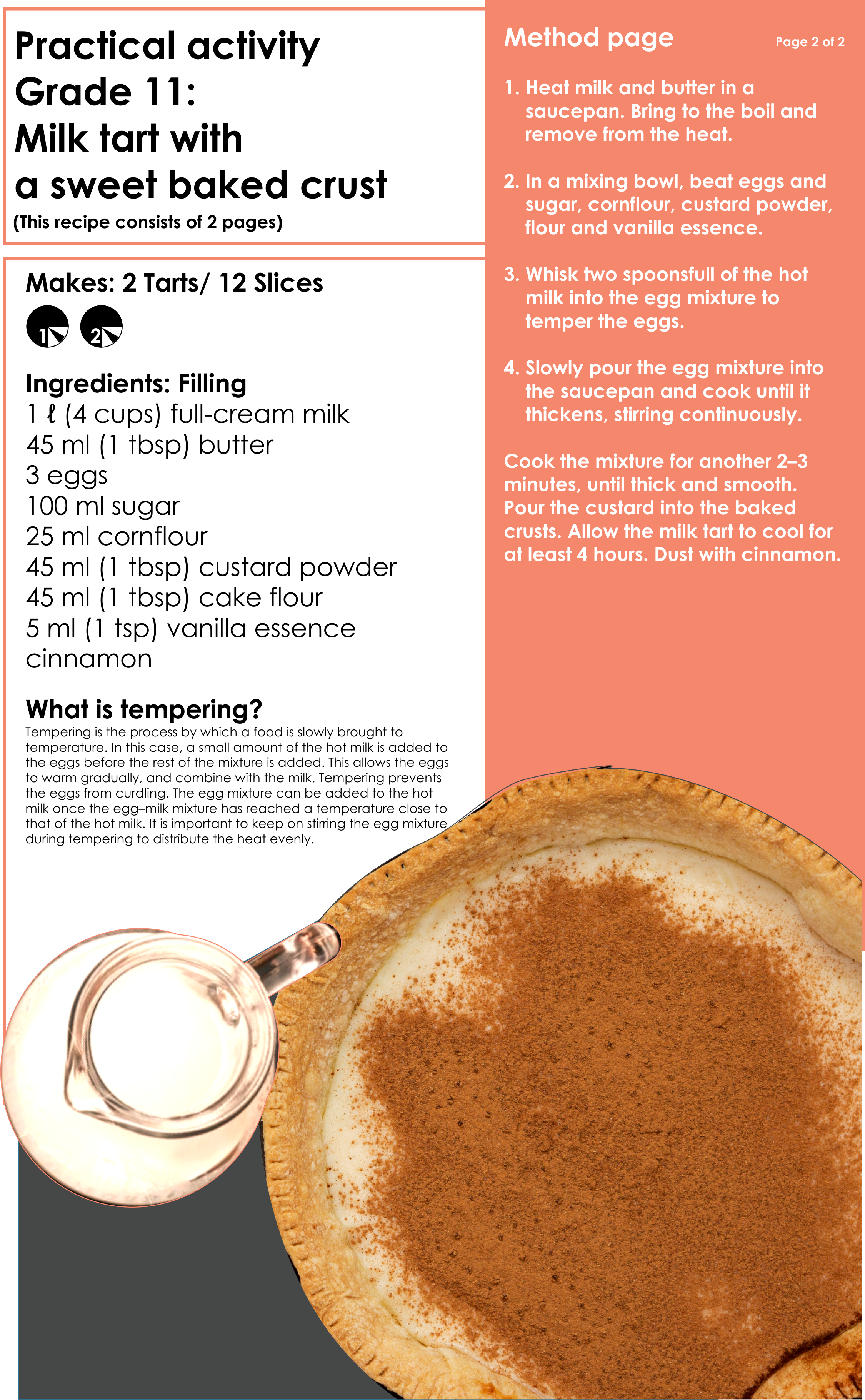
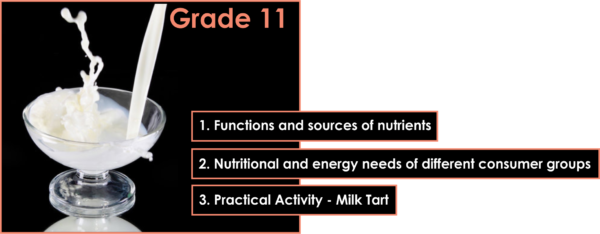
1. Functions and sources of nutrients: Why dairy’s nutrients are good for you.
1.1 Introduction
We need to eat a variety of foods for good health. Our bodies need a diet that supplies enough macro- and micronutrients to give us energy, help us build and repair tissues and protect us against diseases. Protein, carbohydrates and fats are macronutrients. Vitamins and minerals are micronutrients. A diet low in energy or protein may lead to malnutrition, while a diet low in variety may lead to possible micronutrient deficiencies and potentially several health problems.
Milk and dairy contain valuable macro- and micronutrients and have a key role in a balanced diet. Because of its unique and valuable nutrient profile, authorities around the world – including in South Africa – recommend the intake of milk and dairy every day
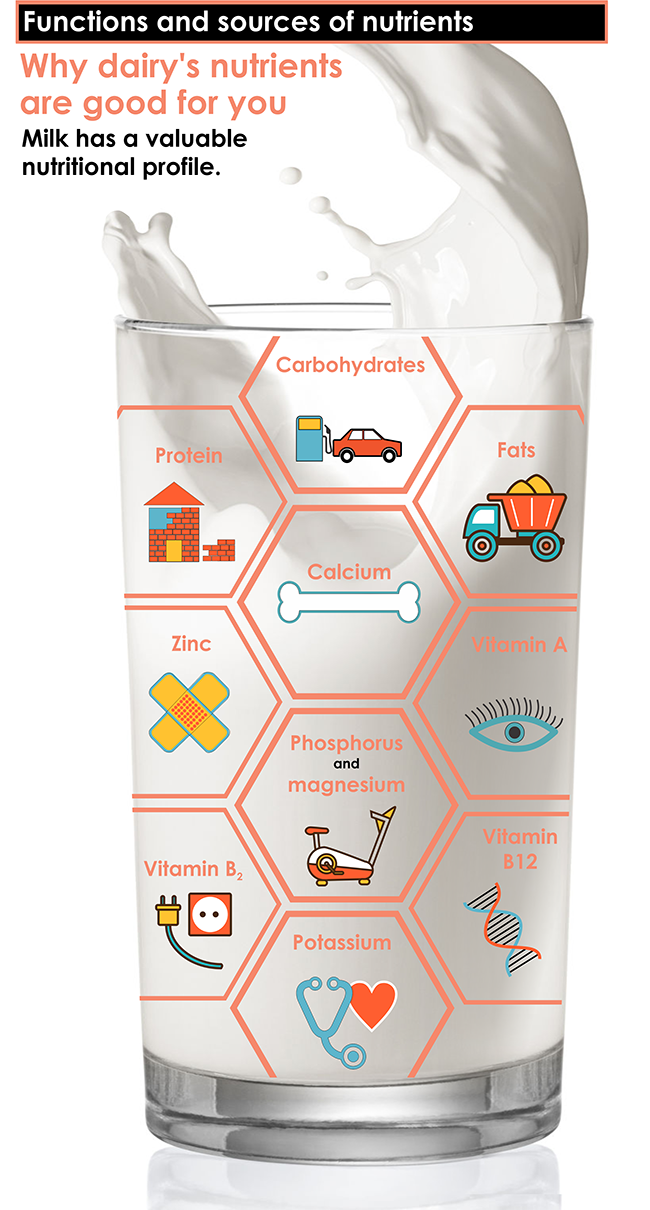
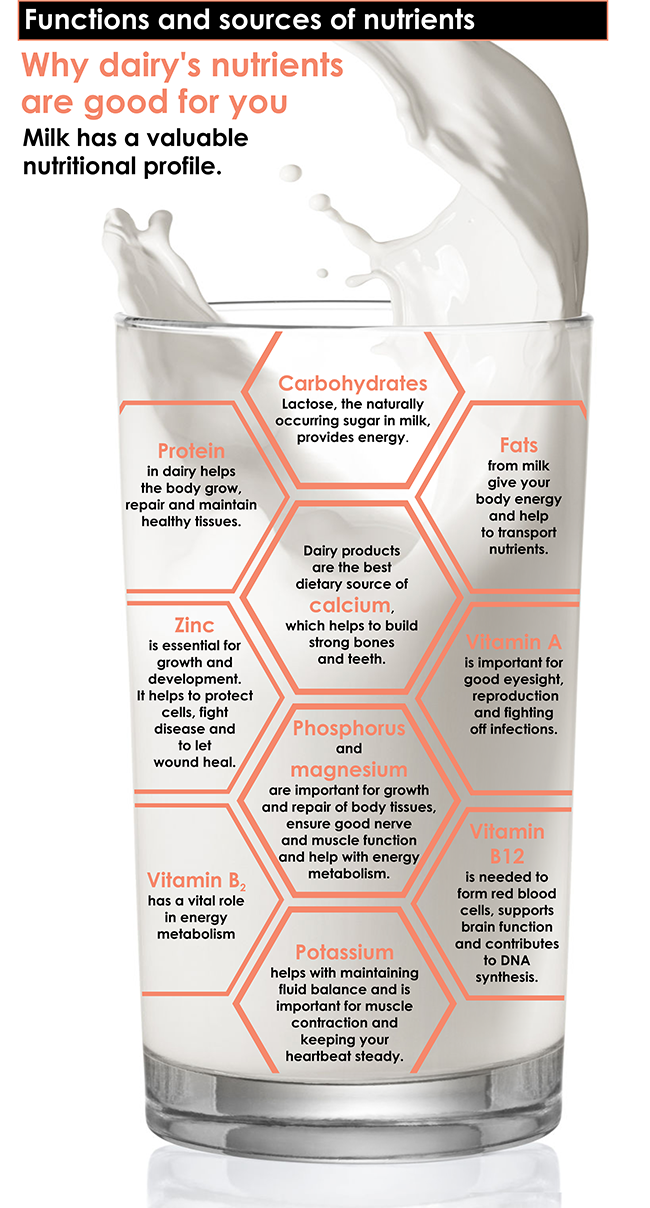
1.2 The nutrient profile of milk
Cow’s milk contains many important nutrients, including protein, calcium, potassium, phosphorus, magnesium, zinc and vitamins A, B2 and B12. The good distribution of macro- and micronutrients in dairy can help to address malnutrition. Milk and dairy can also help to lower the risk of chronic lifestyle diseases.
Milk is a whole food, which means it contains many naturally occurring nutrients. These nutrients work together in a complex food structure called the dairy matrix. The health effects of dairy go beyond that of its individual nutrients – when it comes to milk and dairy, the whole is more than the sum of its parts. Scientists have found that the unique interaction of the nutrients and other bioactive components in dairy contributes to health and wellness. Including milk and dairy foods in your diet will help to keep your bones healthy, your blood pressure in range and your weight under control. The dairy matrix has also been shown to help with heart health, improve your overall gut health and help with lowering the risks of some chronic diseases.
1.3 Macronutrients: Carbohydrates, protein and fats
1.3.1 Carbohydrates
Carbohydrates provide fuel for your body. Lactose – also called milk sugar – is a sugar found naturally in milk. Lactose helps with restoring the glycogen levels in muscle and also improves calcium absorption from the intestinal tract.
Flavoured milk contains a small amount of added sugar, called sucrose. This makes flavoured milk a useful recovery drink after sport or strenuous exercise because together with the naturally occurring lactose these carbohydrates help athletes to replenish their energy stores. However, too many added sugars or refined carbohydrates can lead to overweight and obesity, which in turn may increase your risk for heart disease, high blood pressure and Type 2 diabetes.
1.3.2 Protein
Milk is an excellent source of high-quality protein, providing all the essential and non-essential amino acids used for growth and repair. The protein in milk is therefore said to be ‘complete’. One glass of cow’s milk contains 8g of protein and is ideal to help with building and repairing muscles and other body tissues. Milk is an affordable and convenient whole food, and because it contains complete protein its inclusion in the diet can help to prevent deficiency diseases such as stunting in vulnerable communities.
1.3.3 Fats
Fats are important for insulation, reserve energy supply and to transport fat-soluble vitamins. Milk fat consists of more than 400 fatty acids, each with different effects. Recent research shows that the fats in dairy do not to raise cholesterol and actually help to protect against heart disease. Milk is also lower in fat than you think. Full-cream milk typically contains 3.4% fat, low-fat milk contains 1.5% fat and fat-free milk has <0.5% fat. Comparing this with the fat content in common convenience foods and snacks, such as potato crisps (36%), a hamburger (30%) or chocolate (20–30% fat), shows that, comparatively, milk is not high in fat.
1.4 Micronutrients: Minerals
1.4.1 Calcium

Calcium is the most abundant mineral in the body and essential to get from the diet. An adult’s body contains about 1000 g of calcium, of which almost everything (99%) is found in the bones. The calcium in bones ensures that the skeleton is strong and rigid and also serves as reservoir for calcium needed in the blood to help with clotting. The residual 1% of calcium – in other words, the calcium not in the bones – is found in extracellular fluids, cell organelles and membranes. Calcium also supports muscle contraction and helps with nerve function. Apart from its physiological functions and the role in keeping our bones and teeth strong and healthy, calcium has also been shown to have a role in preventing cardiovascular disease and certain cancers and contribute to weight management.
Calcium cannot be synthesised by the body; it has to be obtained from food. Dairy products are the richest food source of calcium. The calcium from dairy is well absorbed because of its unique combination with protein and phosphorus. Although foods such as sardines, tofu (fortified with calcium), beans (red, white), certain fruit (e.g. figs) and vegetables (e.g. spinach, kale, sweet potato and broccoli), almonds and salmon also contain calcium, the calcium in these foods is not well absorbed by the body.
Your daily requirement for calcium depends on your age. Adults need (19–50 years) need about 1000 mg per day. Teenagers need more – about 1300 mg per day – because this life stage is critical for bone formation and 50% of your bone mass is built during your teenage years. A single serving of dairy – one cup of milk, two small of yoghurt or 40 g of cheese – gives you 300 mg of calcium. This means that having three servings of dairy a day will give you almost all the calcium you need (900 mg).
Not getting enough calcium does not produce obvious symptoms in the short term because the body maintains calcium levels in the blood by taking it from bone. But in the long run, getting too little calcium can affect your health negatively, such as causing low bone mass (osteopenia) and increasing the risk of osteoporosis and bone fractures.
1.4.2 Phosphorus, magnesium and potassium
Phosphorus is part of every body cell. Your body needs phosphorus to make energy and carry out important metabolic processes, such as making proteins needed for building, maintaining and repairing cells and tissues. Together with calcium, phosphorus is also essential for building strong bones and teeth. A phosphorus deficiency can cause loss of appetite, anaemia, muscle weakness, coordination problems and contribute to low bone density.
The role of magnesium is related to the functions of calcium and phosphorus. Magnesium activates many of the body’s enzymes and has a role in making energy available to the body. Although magnesium deficiency is rare, symptoms include fatigue, muscle spasms and stiffness.
Potassium is need for almost every body function, including proper kidney and heart function, muscle contraction and nerve function. Potassium also helps to control blood pressure. A cup of milk contains almost a quarter of the amount of potassium you need per day. Milk is a good source of potassium, especially for people who eat less than 400 g of fruit and vegetables a day. Potassium deficiency can lead to increased blood pressure, depleted calcium in bones and an increased risk of kidney stones. A severe deficiency of potassium, such as often seen in bulimia patients, can become life threatening as it can negatively affect brain function, lead to muscle paralysis, breathing difficulty and an irregular heartbeat.
1.4.3 Zinc
Zinc helps the immune system fight off invading bacteria and viruses. The body also needs zinc to make proteins and DNA, the genetic material in all cells. During pregnancy, infancy and childhood, zinc helps the body to develop and grow. Zinc also helps wounds heal and is important for a proper sense of taste and smell. Having too little zinc may cause slow growth in infants and children, delayed sexual development in adolescents, male impotence, hair loss, diarrhoea, eye and skin sores, and a loss of appetite. Problems with wound healing, decreased tasting ability and lower alertness levels can also occur if you do not get enough zinc.
1.5 Micronutrients: Vitamins
1.5.1 Fat-soluble vitamins
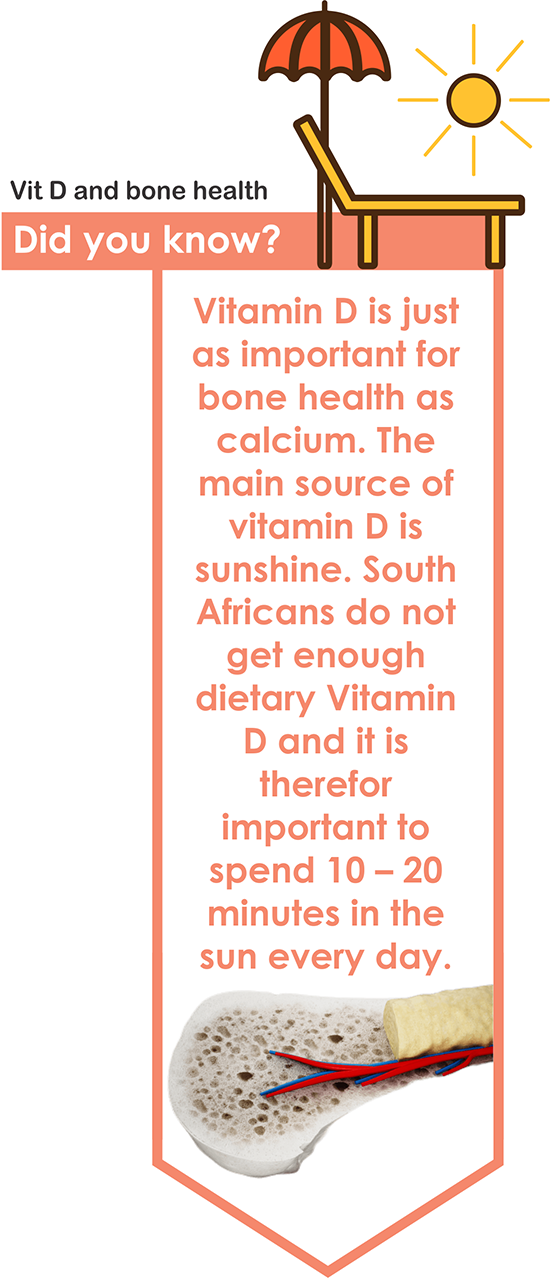
Vitamin A (also known as retinol) is found in the fat (cream) of full-cream milk. It has an important role in developing proper eyesight, keeping the immune system strong and reproduction. It also helps form and maintain healthy teeth, tissue, mucus membranes and skin. Vitamin A furthermore has a role in a healthy pregnancy and breastfeeding. People who live in poor socio-economic conditions often have a vitamin A deficiency, and it is most often seen in young children and pregnant women in this group.
Fresh milk is fortified with vitamin D in many countries around the world, but not in South Africa. This is because the body makes vitamin D when the skin is directly exposed to the sun. In sunny countries such as South Africa, people generally get enough sunshine to make all the vitamin D the body needs. Too little of this vitamin may lead to the development of soft, brittle bones. Long periods of cloudy days, staying indoors all the time and having dark skin can affect the amount of vitamin D the body makes.
1.5.2 Water-soluble vitamins
Vitamin B2 (also called riboflavin) helps break down macronutrients and is vital in maintaining energy supply. Riboflavin deficiency can cause skin disorders, sores at the corners of your mouth, swollen and cracked lips, hair loss, a sore throat, liver disorders, and problems of the reproductive and nervous systems. Severe, long-term deficiency causes anaemia and eye cataracts.
Vitamin B12 is required for forming red blood cells, supporting brain function and making DNA. Having too little of this vitamin can contribute to anaemia, fatigue, constipation, loss of appetite and weight loss. It can also lead to numbness and tingling in the hands and feet and difficulty in maintaining balance. Vitamin B12 deficiency can also negatively affect mental health, and contribute to depression, confusion, dementia and poor memory.
1.6 Glossary
deficiency: having too little of a nutrient from food
dairy matrix: the unique combination and interaction of nutrients in dairy
glycogen: a complex carbohydrate found in muscle tissue and serves as carbohydrate stores in the body
malnutrition: a lack of proper nutrition caused by eating too little or having too little variety in the diet
osteoporosis: a disease in which the bones become brittle, causing them to fracture easily
anaemia: a condition caused by a lack of red blood cells, leading to severe fatigue
enzymes: proteins that speed up metabolism
2. Nutritional needs of different consumer groups
2.1 Introduction
Nutrient reference intakes are used across the world as guidelines to help people get enough nutrients for general good health. The Food and Nutrition Board of the Institute of Medicine in the US developed a broad set of reference values for dietary nutrient intakes, including calcium. These dietary reference intake (DRI) values form the basis of setting recommended dietary allowances (RDAs) for individuals. DRI values can be seen on food labels.
People’s dietary needs change over the course of their lives. Men and women may also have different dietary needs during certain life stages. It is important to know what people’s dietary needs are at different stages of their life to ensure continued good health. [See also: link to Educational Tool].
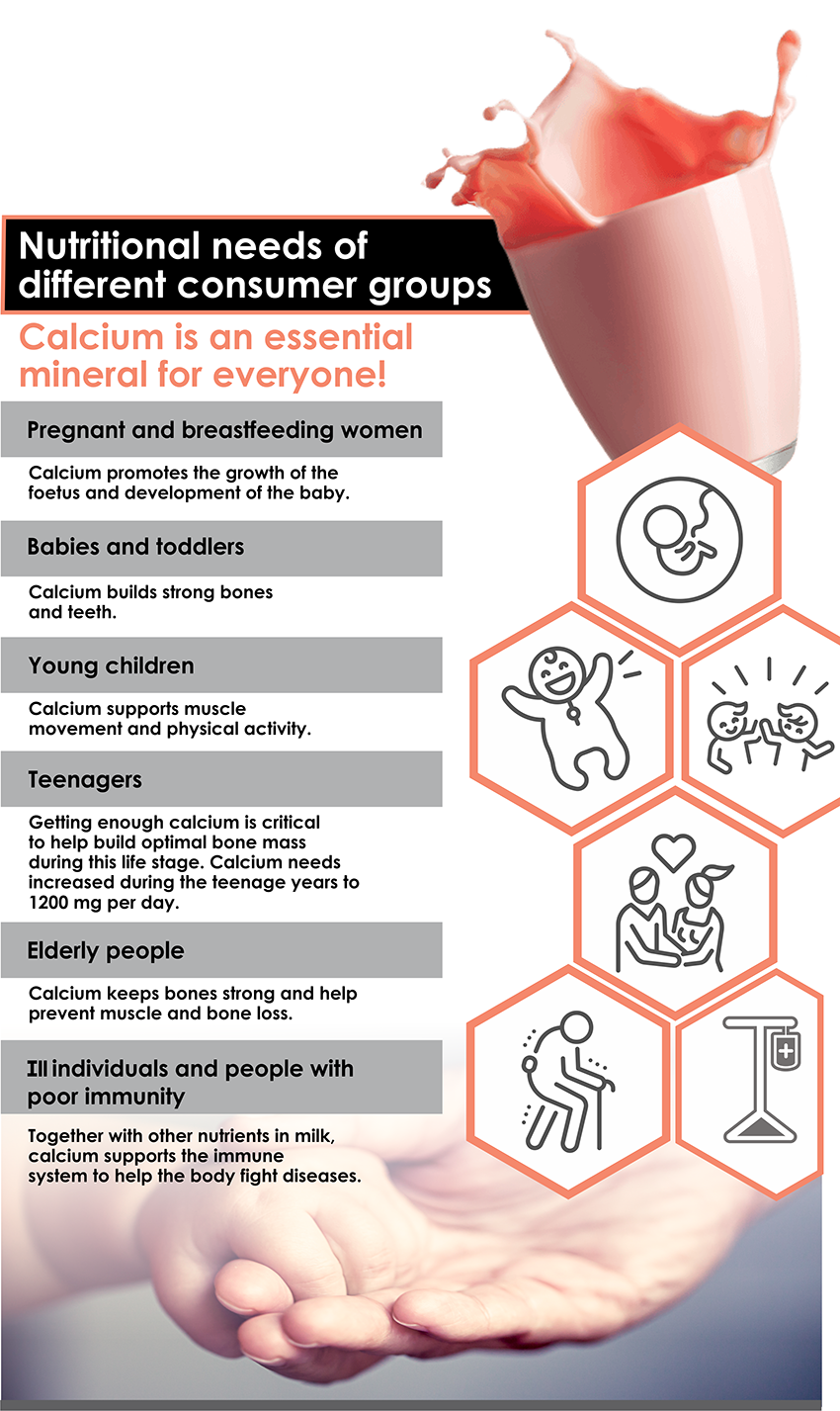
2.2 Pregnant and lactating mothers
Pregnancy and lactation (breastfeeding) increase a woman’s nutritional needs. To deliver a healthy baby, the mother must ensure that her diet contains enough healthy, nutrient-rich foods to support both herself and the developing foetus. A new mother also needs to eat healthy, nutritious food to help her produce enough breast milk to feed her baby. Exclusive breastfeeding from birth to 6 months will help the baby to grow well and stay healthy.
Consuming protein is critical to allow proper brain development of the foetus. Three portions of protein are needed per day. The high-quality protein in milk, which includes all the essential amino acids the body needs, makes dairy a perfect pregnancy partner.
Calcium is essential for forming a baby’s bones and teeth and dairy products are considered the richest food source of calcium. Calcium from milk and dairy is well absorbed, and a recommended daily intake of 4 servings of milk and dairy will help pregnant women to reach the daily goal of 1 200 mg of calcium (1 300 mg for teenagers who are pregnant or breastfeeding). Although sardines, broccoli, spinach, white beans and almonds are also good sources of calcium, the mineral is not as easily absorbed from these sources as from milk and dairy.
A pregnant woman needs 27 mg iron per day and 9 mg per day when she is breastfeeding. Getting enough iron helps to keep red blood cells healthy, which supports optimal oxygen transport. Eating foods that are rich in folic acid, such as grains, green vegetables (spinach, broccoli), meats (liver) and legumes (lentils and kidney beans, will help the foetus to develop and fibre-rich foods such as whole grains will help to alleviate constipation, which is common among pregnant women.
2.3 Babies and toddlers
Good nutrition during infancy and early childhood is the foundation for a healthy future. Babies and toddlers have a fairly high basal metabolic rate (BMR), as they do not yet have a well-developed nutrient store.
A baby should best be fed only breast milk for the first six months after birth. After that, complementary feeding can be introduced to ensure optimal physical, mental and cognitive growth and development. Babies need 200 mg of calcium per day for the first six months of life and 260 mg per day between the age of seven and 12 months. Between the ages of 1 and 3 years, the RDA for calcium is 700 mg.
Babies can be introduced to yoghurt and cheese from 7 months old. This will help to support bone growth and strengthen their teeth, and also neutralise acids to prevent cavities. Sufficient vitamin D (obtained from safe exposure to sunlight and dietary sources such as egg yolk) will help the baby’s body to absorb calcium, and so contribute to the development of strong, healthy bones.
Babies can be given complementary foods more often as they get older. Iron-fortified baby cereals and pureed meat will ensure adequate iron intake for the healthy development of the nervous system. Dairy products also contain folate (vitamin B9), which is important for cell division during this stage, and zinc, which helps with growth and immune support.
It is best to provide meals and snacks that contain healthy fats to sustain energy levels and support brain development. Full-cream milk, fermented milk and yoghurt are healthy options, because they contain fat as well as the protein needed for growing bodies. Babies can be introduced to fresh full-cream milk from the age of 1 year.
2.4 Young children
Including dairy in children’s meals and snacks is a good way to help them reach the daily required amount of calcium. Young children need up to 1300 mg calcium per day (1000 mg for children between 4 and 8 years old; 1300 mg for children between 9 and 13 years old). Calcium is the most abundant nutrient stored in the body and key to building the skeleton and maintaining bone mass throughout life. Calcium is vital for developing healthy teeth during childhood, when baby teeth are replaced with permanent ones.
Having milk or maas with porridge at breakfast will help children to start their day well. Milk and dairy contain good-quality protein to help with growth and development, and are the richest dietary source of calcium. Full-cream milk, maas, yoghurt, flavoured milk and cheese slices are excellent, nutrient-rich snack options.
Children of school-going age need enough vitamin A in their diet to ensure healthy eyes and build a good defence against illnesses. Full-cream milk is a valuable source of vitamin A for young children. Regular meals and a variety of foods rich in iron and zinc (for a strong immune system) are also important. Eating fruit high in vitamin C will help with iron absorption.
2.5 Teenagers and young adults
The growth spurt that occurs in adolescents (between the ages of 10 and 15 years in girls; between 12 and 19 years in boys) increases their RDA for calcium to 1300 mg. After the age of 19, the RDA of calcium settles at 1000 mg per day.
About 50% of a person’s bone mass is built during the teenage years and lots of calcium must be deposited in the skeleton to prevent osteoporosis later in life. In children and adolescents, the body builds new bone faster than it breaks down old bone, so the total bone mass increases. Dairy products are rich in calcium and it is easily absorbed by the body from these foods. Calcium, phosphorus, vitamin D and physical exercise are the ideal combinations to maximise bone mass during this phase.
Teenagers should be encouraged not to substitute milk with soft drinks or to eat take-away foods too often. Eating too much convenience or instant foods could lead to a low intake of calcium-rich foods. Skipping meals, especially breakfast, can also limit calcium intake and compromise overall quality of the diet. Teenagers with weight concerns should be encouraged rather to consume low-fat dairy than avoiding dairy altogether, as the calcium content is the same in full-cream, medium-fat, low-fat and fat-free milk.
2.6 Elderly people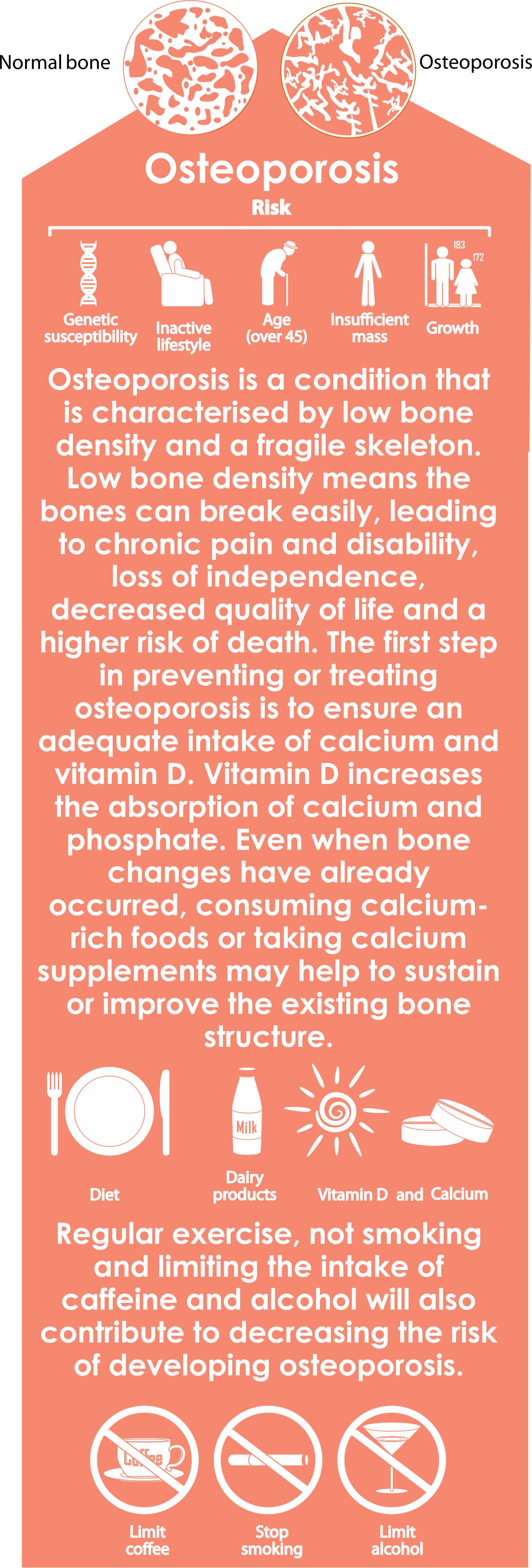
It is important for older people to get enough calcium. Bones are constantly being remodelled as calcium moves in and out from bone by the action of bone-building enzymes. After the age of 30, the body does not add more bone tissue and simply maintains its existing bone mass. In older adults (typically women older than 52 and men older than 65 years), bone is broken down faster than it can be built up. This means elderly people experience a bone-loss phase. If their calcium intake is too low, they can develop osteopenia or osteoporosis, a condition in which the bones become brittle and can break easily.
The RDA for calcium for people older than 71 years is 1200 mg, but women should ideally increase their intake to this level already after menopause (typically from 52 years of age). Dairy products such as cheese, milk and yoghurt are still the best sources of calcium for elderly people. Dairy is also an excellent source of good-quality protein, which not only supports bone health but also prevents the loss of muscle strength, helping older people stay strong and independent for longer.
2.7 Ill and convalescing people
Nutrition is important in helping a sick person recover. Calcium, together with other nutrients in dairy, supports immune function. It triggers immune cells to release nutrients where needed to fight infection and speed up healing. Increasing the amount of calcium-rich foods in the diet of someone who is recovering from illness is therefore important.
Yoghurt is a good choice for people with reduced appetite. Other options are a high-energy smoothie made with full-cream milk, flavoured milk or cubes of frozen full-cream or flavoured milk. Custard and double-cream yoghurt can also help to provide for the nutritional demands of someone who is ill. Milk and dairy are nutrient-rich foods and can help to fill nutrient gaps.
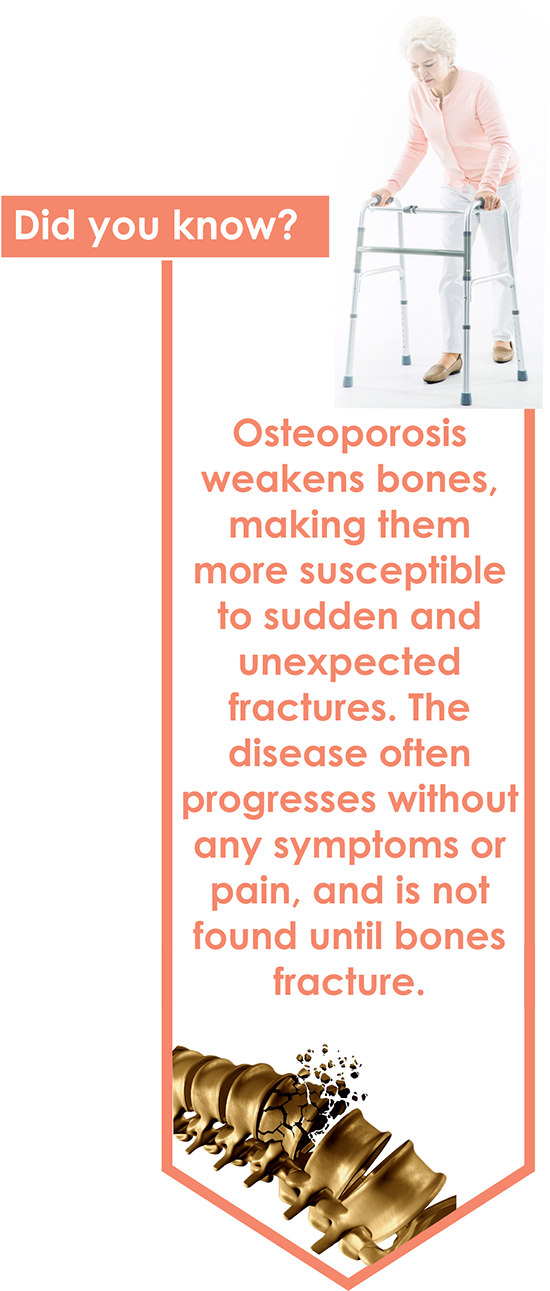
2.8 Glossary
dietary reference intake (DRI): a set of values used to plan and assess nutrient intakes for general good health
recommended daily allowance (RDA): the intake of essential nutrients required to meet the needs of a healthy person
basal metabolic rate (BMR): the rate at which the body uses energy to fulfil basic, vital processes such as breathing and keeping the heart beating
complementary foods: foods or drinks other than breast milk or infant formula (e.g., infant cereals, fruits, vegetables, water)
amino acids: the building blocks of proteins
3. Practical Activity – Milk tart with a sweet baked crust.
